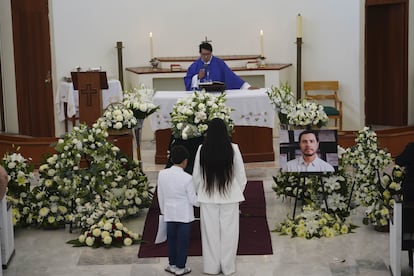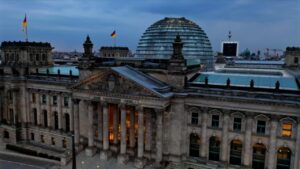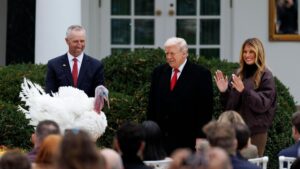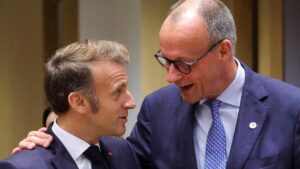
There are deaths that become symbols and sometimes even turning points. The assassination of the mayor of Uruapan, Carlos Manzo, triggered a social protest rarely seen in Michoacán, sadly accustomed to pain and helplessness. The epidemic even led Claudia Sheinbaum’s federal government to react. But almost 20 years ago, a few blocks from the municipal square where the mayor was killed point blank, another episode occurred that marked the recent memory of the country. In the early morning of September 6, 2006, about twenty hooded men, armed with assault rifles and dressed in police uniforms, entered a nightclub shooting. Before leaving, they took five human heads out of a bag and left them on the dance floor. Three months later, in one of the first displays of narco-terrorism in Mexico, President Felipe Calderón announced that he would take the military into the streets once he came to power. The unfortunate war on drugs began, with tens of thousands dead and missing.
It was in Michoacán that the barracks was first opened. When President Calderón, dressed in an olive green beret and a military jacket with the eagle and five stars on the lapel, arrived at the Uruapan airport to tell the troops from deep in Michoacán, Apatzingán, the heart of violence in the Terra Caliente: “In this great national effort, in which you are at the forefront of the battle, what we seek is to stop the advance of crime.” That year the police collected 17 human heads from the streets and the murders doubled. 6,000 soldiers arrived in Michoacán to confront the cartels. In the next six-year term, Enrique Peña Nieto expanded the strategy. And then Andrés Manuel López Obrador began to move further away but without bringing the soldiers back to the barracks.
The history of figures of violence in Michoacán in recent years is eloquent. In 2006 there were almost 700 murders. There was some reduction in the interval, but last year ended with more than 1,000 deaths. Michoacán is the symbol of Mexico’s interminable security crisis, of failed strategies, of the corrosion of politics and the economy by organized crime and of the evolution of mafias: from the drug business to extortion, to the parasitism of the juicy business of the state. From the avocado of Uruapan, to the lemon of Tierra Caliente or to the trade routes with Asia from the port of Lázaro Cárdenas, one of the largest in the Latin American Pacific.
In Uruapan they continue to watch over their mayor, who is very popular for tackling crime head on. But they also remember the severed heads of 2006, the bombs in the capital’s Zócalo in 2008, the bodies hanging from bridges, the disappearances, the anti-personnel mines, the drones with explosives. There are candles, flowers and signs at the exact spot where Manzo was killed. People cross the square and stop to read messages in the shade of giant tropical trees. Without losing sight of his grandson running through the square, a grandfather remembers that “before the violence was worse. Then it diminished a bit. But it’s like with the wasps: when the tombstones, they respond by attacking. Behind all this there are the gentlemen. They want to take the wool and in the middle there are us poor people who don’t even know what to say anymore. It seems like a curse”, says Benjamin García, a 71-year-old plumber who hasn’t worked for a long time due to a head injury. hand.
This curse may have to do with the fact that Michoacán is one of the poorest states in the country – more than 40% of the population is below the poverty line – and has economic drivers as powerful as being the world’s leading producer of avocados, lemons and red fruits; host a steel plant for ArcelorMittal, the world’s largest steel producer; or have Chinese and European giants running the port. Economist Carlos Heredia, an advisor to the state government from 2002 to 2008, explains it this way: “It’s not that violence is ingrained in the DNA of Michoacans, it’s that there’s a lot of money here. And this is a magnet for crime. It’s a rich state with poor people.”
Michoacán’s turbulent history dates back to the development policies inherited from the Revolution. President Lázaro Cardenas, one of the fathers of modern Mexico, promoted an agrarian reform in the 1950s that gave impetus to the development of the countryside. But that momentum slowed, and Michoacan farmers began to join the ranks of braceros, the mass exodus of agricultural workers to the United States. “This decline has led to the formation of armed groups, common criminals dedicated to land expropriation and theft. Furthermore, the departure of so many people to the United States has favored a natural channel for the transfer of drugs in small quantities. The result is a current scenario in which cartels have diversified their criminal activities and increased their firepower in response to militarization,” explains political analyst specializing in Michoacán Lorena Cortés.
The evolution of crime in Michoacán, particularly in the Tierra Caliente valley, is a moving snapshot of the various changes that have occurred in the sector and the key stages of the security crisis. Since the 1960s, the area’s dry, hot climate has favored marijuana crops. In that first period there was also a certain permissiveness on the part of the authorities. But the eye ended in 1985 with the kidnapping and vicious murder of DEA agent Kiki Camarena. His body was found on a ranch in Michoacán, near the border with Jalisco. US pressure and new businesses have changed the landscape. The Asian precursors of synthetic drugs began to enter from the port of Lázaro Cárdenas. At the beginning of the century, Michoacán becomes the territory of the Zetas, a mafia made up of deserters from an elite corps of the Mexican army.
The Zetas, pioneers of extreme violence that continues today, entered with a local and bizarre mafia, La Familia Michoacana, with a pseudo-mystical and regionalist spirit. They were responsible for the severed heads in the nightclub, along with this message: “This is divine justice. The Family does not kill the innocent”. The alliance broke down in 2006 and the violence reached unimaginable limits. With the military already in the streets, poor farmers took up arms, forming self-defense groups. Peña Nieto’s government focused on capturing major drug lords. With the large criminal organizations decapitated, a new mutation occurs: a galaxy of new atomized groups thirsty to take advantage of every corner. Extortion has arrived, anti-personnel mines, drones equipped with explosives and even the appearance of Colombian mercenaries hired by the mafia.
This leads to the current scenario, where the main protagonist of the criminal map of Michoacán, and much of the country, is the Jalisco New Generation Cartel (CJNG). A modern mafia born in the midst of the decline of the classic cartels and which functions more like a franchise, a brand very far from the old criminal codes, which were dedicated to drugs and excluded extortion and kidnapping of the population. The fight in Michoacán is CNJG against everyone: against Carteles Unidos, which controls much of Apatzingán and maintains a border battle with Jalisco that devastates entire cities. Against Los Viagras, who subjugate the lemon area. Or against the last remnants of La Familia, located in the border areas with Guerrero and the State of Mexico.
In fact, the CNJG has one of its strongholds in Michoacán. This is Aguililla, the hometown of its leader, El Menchoone of the DEA’s most wanted criminals. For months it functioned practically as a zone liberated from the authority of the State, where criminals made and unmade before the eyes of the Army, deployed on the edge of the city. An example of the containment policy implemented by López Obrador’s government.
Councilor Heredia summarizes how the relationship between crime and politics has changed. “We went from tolerance to complicity. It became natural for drug traffickers to finance campaigns to influence especially the municipalities. From there we moved on to joint association and now we are in subordination. Crime is what decides what is done and anyone who opposes is killed.” This is what happened to Mayor Manzo, who had the Jalisco cartel in his sights. Or the citrus fruit producer Bernardo Bravo, who raised his voice against extortion against the farmers of Terra Caliente.

The penetration of crime into politics has also left well-known cases. In 2009, the Attorney General accused Julio César Godoy, half-brother of Governor Leonel Godoy, of having ties to La Familia Michoacana, shortly after he won election as a federal representative. In 2014, a son of the then governor, Fausto Vallejo, appeared on video chatting calmly with a boss of the Knights Templar, a splinter of the Familia Michoacana. The images showed the governor’s son drinking beer with La Tuta as they analyzed the situation in the state. Five days later, the president submitted his resignation.
President Sheinbaum reacted to the social outburst of the last few days in the state. From Apatzingán to the capital itself, protests took place demanding justice and security. The president presented a specific plan that involves sending federal forces and creating presidential offices in several municipalities, starting with Uruapan. The presidential initiative resumes some of the measures applied in the previous six years. Like Peña Nieto’s dispatch in 2014 of a special commissioner for security and development of Michoacán. The president insisted that his plan does not include the militarization of the state or the application of past strategies. The analysts consulted for this report are asking for time to verify whether this new recipe will succeed in imposing some peace in this indomitable land.





